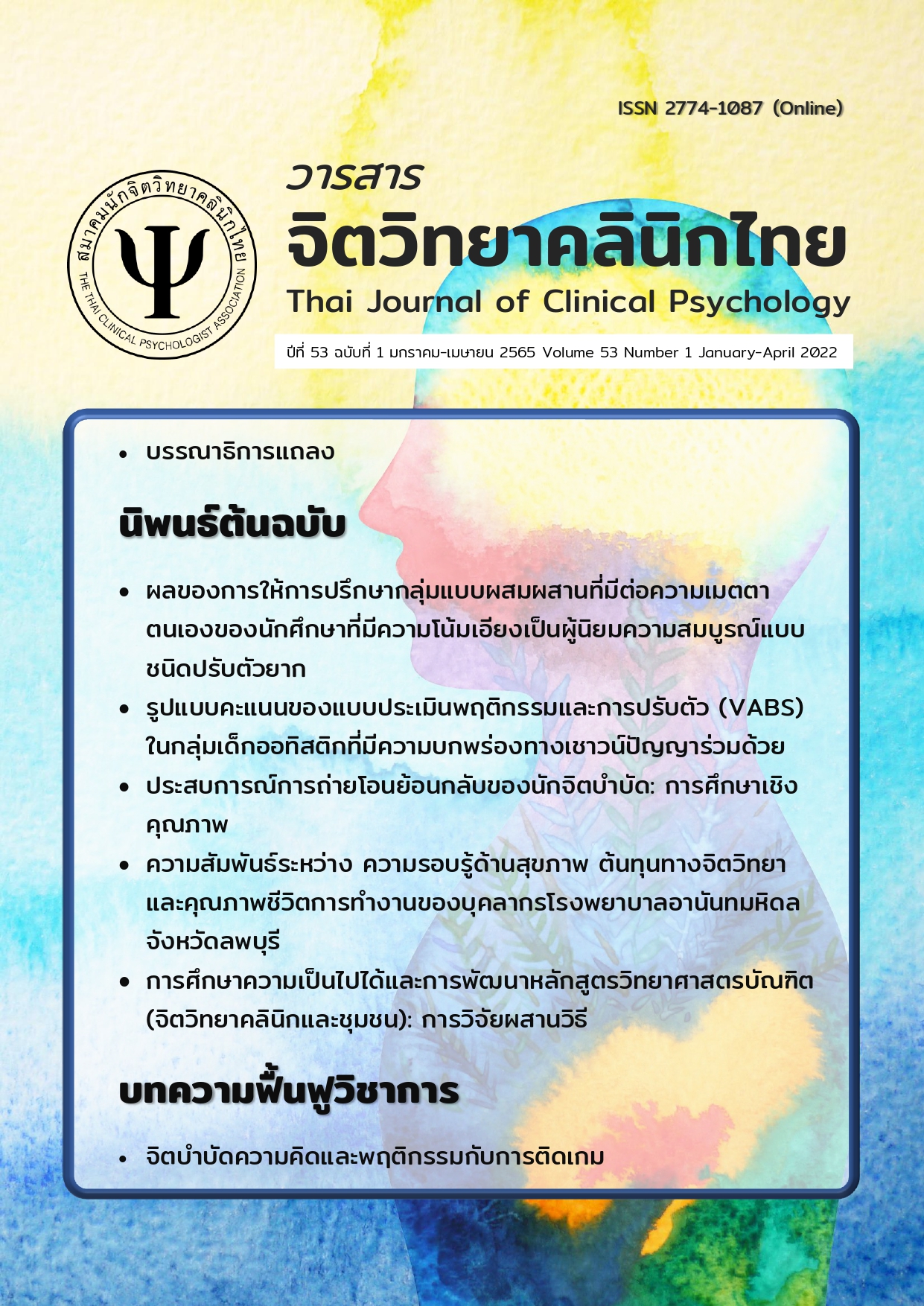Countertransference Experience of Psychotherapists: A Qualitative Study
Main Article Content
Abstract
Objectives: The aim of this qualitative research is to explore the psychological experiences of psychotherapist’s countertransference in the therapeutic process. Materials and Methods: The data were collected via semi-structured in-depth interviews and analyzed using Interpretative Phenomenological Analysis (IPA). The participants included six psychotherapists who have 5 – 10 years of therapeutic practice and had countertransference experience in the therapeutic process. Result: The findings found the main theme which included the familiarity of experiences between psychotherapists and clients, the sympathetic feelings to clients, and psychotherapists’ unability to contain their feelings Conclusion: This finding increase a better understanding of countertransference experience and are useful for psychotherapists to be aware of the importance of countertransference which is inevitable.
Article Details

This work is licensed under a Creative Commons Attribution-NonCommercial-NoDerivatives 4.0 International License.
เรื่องที่ลงตีพิมพ์ในวารสารจิตวิทยาคลินิกแล้วถือเป็นลิขสิทธิ์การเผยแพร่โดยวารสารจิตวิทยาคลินิกแต่เพียงผู้เดียว การตีพิมพ์หรือเผยแพร่ซ้ำในที่อื่นต้องได้รับอนุญาตจากกองบรรณาธิการวารสารฯ
References
Bleimling, J. (2021). Nonverbal moments of meeting–an analysis of three psychodynamic therapy sessions. Body, Movement and Dance in Psychotherapy, 1-16.
Cartwright, C., Hayes, J. A., Yang, Y., & Shires, A. (2021). “Thinking it through”: Toward a model of reflective practice for trainee psychologists’ countertransference reactions. Australian Psychologist, 56(2), 168-180.
Casement, P. (2013). Further learning from the patient: The analytic space and process. Routledge.
Clarkson, P., & Nuttall, J. (2000). Working with countertransference. Psychodynamic Counselling, 6(3), 359-379.
Cobb, S. M. (2015). What passes between client and therapist? PSYCHOLOGIST, 28(7), 600-602.
Cohen, M. B. (1988). Countertransference and anxiety. In B. Wolstein (Ed.), Essential papers on countertransference (pp. 64-83). New York University.
Freud, S. (1988). The future prospect of psychoanalytic therapy. In B. Wolstein (Ed.), Essential papers on countertransference (pp. 16-24). New York University.
Frie, R., & Orange, D. (2009). Beyond postmodernism: New dimensions in clinical theory and practice. Routledge.
Gabbard, G. O. (2001). A contemporary psychoanalytic model of countertransference. Journal of Clinical Psychology, 57(8), 983-991.
Gelso, C. J., & Hayes, J. (2007). Countertransference and the therapist’s inner experience. Lawrence Erlbaum Associates.
Gluhoski, V.L. (1994). Misconceptions of cognitive therapy. Psychotherapy: Theory, Research, Practice, Training, 31(4), 594-600.
Grant, J., & Crawley, J. (2002). Transference and projection: Mirrors to the self. McGraw-Hill Education (UK).
Hayes, J. A., McCracken, J. E., McClanahan, M. K., Hill, C. E., Harp, J.S., & Carozzoni, P. (1998). Therapist perspectives on countertransference: Qualitative data in search of a theory. Journal of counseling psychology, 45(4), 468-482.
Kara, S. (2020). Understanding therapists' experiences with countertransference: A move towards better training, supervision, and practice [Master’s thesis, University of Ottawa]. Recherche uO Research. http://dx.doi.org/10.20381/ruor-24670
Kiesler, D. J. (2001). Therapist countertransference: In search of common themes and empirical referents. Journal of Clinical Psychology, 57(8), 1053-1063.
Kiss, K. D. (2021). Trauma and empathy–A phenomenological analysis of Sándor Ferenczi’s intersubjective technique. Imágó Budapest, 10(1), 6-18.
MacLaren, C. (2008). Use of self in cognitive behavioral therapy. Clinical Social Work Journal, 36(3), 245-253.
Pietkiewicz, I., & Smith, J. A. (2014). A practical guide to using interpretative phenomenological analysis in qualitative research psychology. Psychological journal, 20(1), 7-14.
Prasko, J., Diveky, T., Grambal, A., Kamaradova, D., Mozny, P., Sigmundova, Z., Slepecky, M., & Vyskocilova, J. (2010). Transference and countertransference in cognitive behavioral therapy. Biomedical Papers, 154(3), 189-197.
Racker, H. (1957). The meanings and uses of countertransference. The Psychoanalytic Quarterly, 26(3), 303-357.
Richards, B. M. (2000). Impact upon therapy and the therapist when working with suicidal patients: Some transference and countertransference aspects. British Journal of Guidance & Counselling, 28(3), 325-337.
Rosenberg, L. B., Brenner, K.O., Jackson, V.A., Jacobsen, J.C., Shalev, D., Byrne-Martelli, S., & Cramer, M.A. (2021). The meaning of together: Exploring transference and countertransference in palliative care settings. Journal of Palliative Medicine, 24(11), 1598-1602.
Rowan, J., & Jacobs, M. (2002). The therapist's use of self. McGraw-Hill Education (UK).
Schendel, C. (2010). Trainee’s ability to manage countertransference: An exploration of emotional intelligence and counselor self-efficacy [Doctoral dissertation, Pennsylvania State University]. Penn State Electronic Theses and Dissertations for Graduate School. https://etda.libraries.psu.edu/catalog/11034
Sherby, L. B. (2009). Considerations on countertransference love. Contemporary psychoanalysis, 45(1), 65-81.
Smith, J. A., Flowers, P., & Larkin, M. (2009). Interpretative phenomenological analysis: Theory, method, and research. Sage.
Srichannil, C. (2017). Interpretative phenomenological analysis: A qualitative methodology for psychological research. Journal of Education Burapha University, 28(3), 1-13. (in Thai).
Srichannil, C. (2019). Interpretative phenomenological analysis: Quality criteria. Journal of Education Burapha University, 28(3), 1-13.
Tarnopolsky, A. (1995). Understanding countertransference. Psychoanalytic Psychotherapy, 9(2), 185-194.
Vyskocilova, J., & Prasko, J. (2013). Countertransference, schema modes and ethical considerations in cognitive behavioral therapy. Activitas Nervosa Superior Rediviva, 55(1-2), 33-39.
Winnicott, D. W. (1949). Hate in the countertransference. International Journal of Psychoanalysis, 30, 69-75.
Winnicott, D. W. (1988). Counter-transference. In B. Wolstein (Ed.), Essential papers on countertransference (pp. 262-269). New York University.
Wosket, V. (1999). The therapeutic use of self: Counselling practice, research and supervision. Routledge.
Zachrisson, A. (2009). Countertransference and changes in the conception of the psychoanalytic relationship. International Forum of Psychoanalysis 18(3), 177-188.


